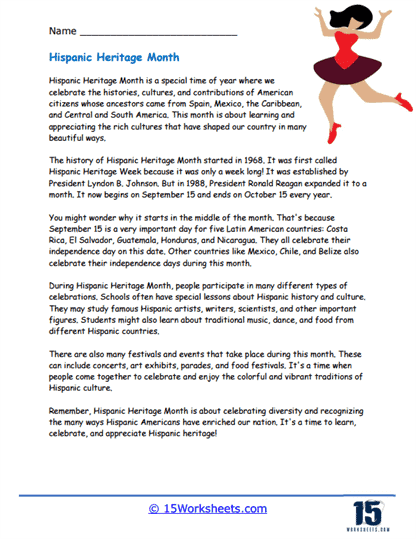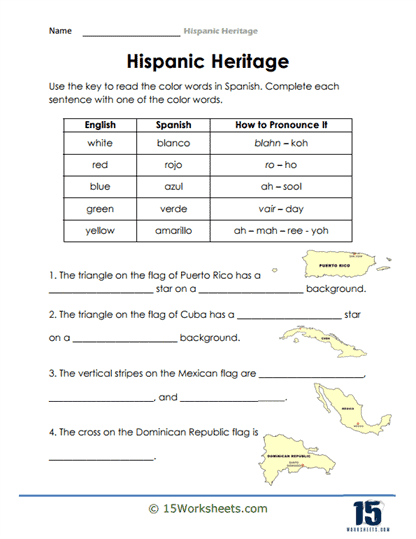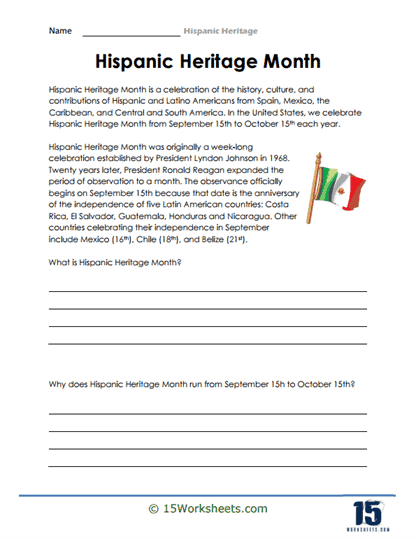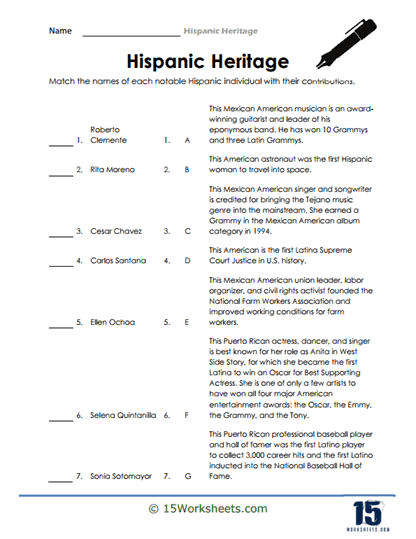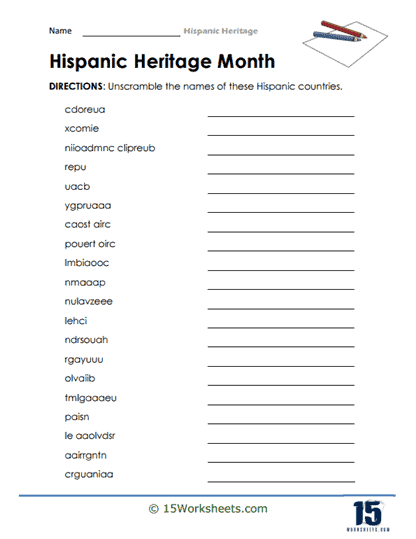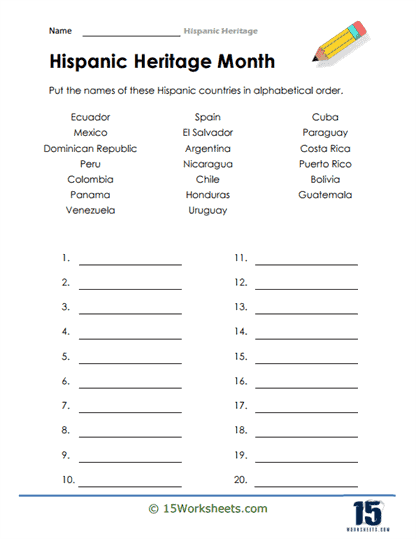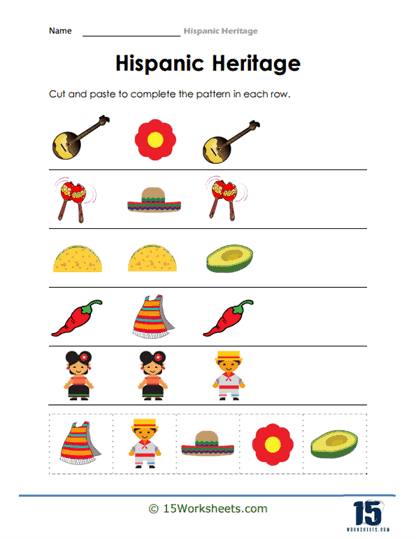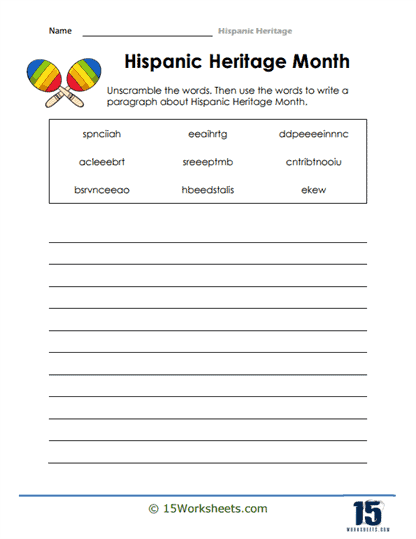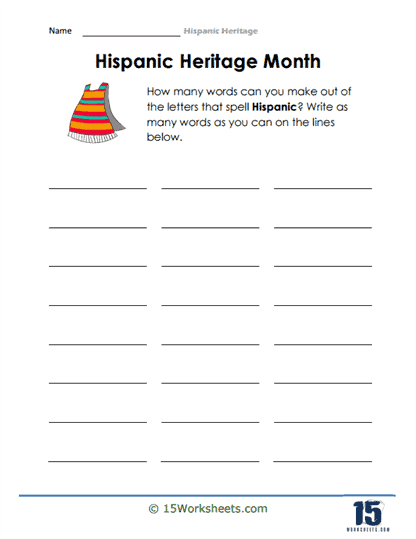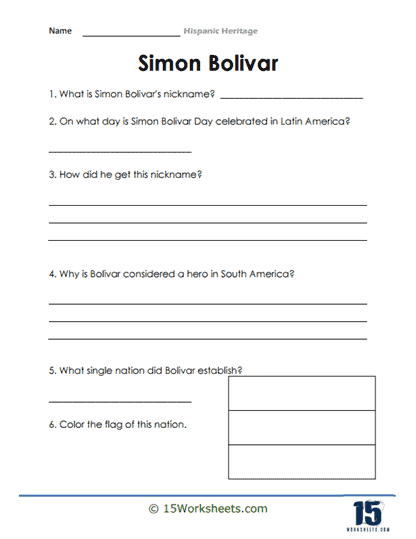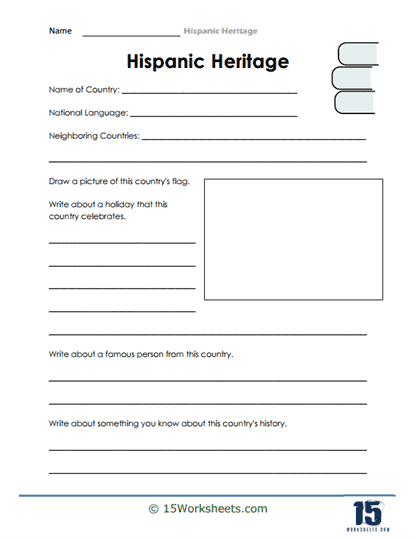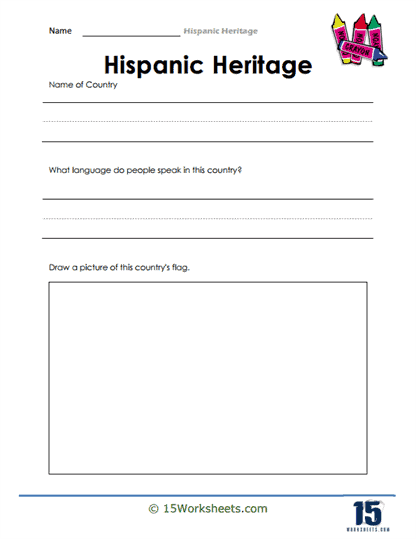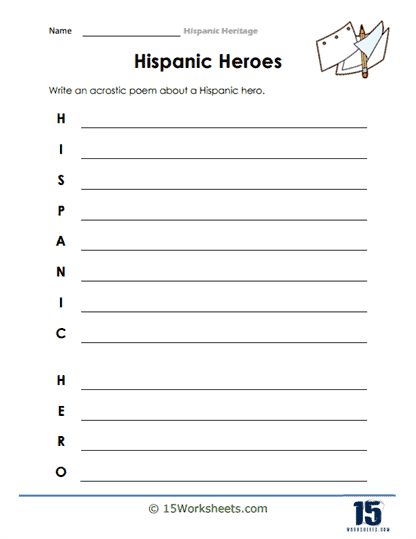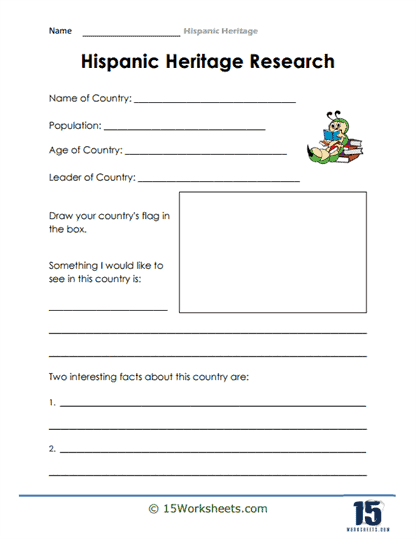Hispanic Heritage Month Worksheets
All About These 15 Worksheets
This series of 15 worksheets is a vibrant, immersive resource designed to inspire students while celebrating the rich diversity, history, and contributions of Hispanic and Latino cultures during Hispanic Heritage Month. These worksheets offer an engaging way for students to delve into the achievements, traditions, and influential figures that have shaped Hispanic and Latino heritage. Through a variety of hands-on activities, students are encouraged to explore and appreciate this dynamic culture, while also developing essential academic skills such as critical thinking, vocabulary expansion, and cross-cultural understanding.
At its core, this collection serves as an important educational bridge between students and the wealth of Hispanic cultural contributions. It opens the door to meaningful discussions about the origins of Hispanic Heritage Month, the historical and socio-cultural significance of its celebration, and the impact of notable Hispanic individuals throughout history. Each worksheet provides a distinct opportunity for students to deepen their understanding while engaging in thought-provoking exercises that inspire cultural appreciation and empathy.
One of the key features of the worksheets is the focus on language development. Students are introduced to basic Spanish vocabulary, particularly color words, and are prompted to use these terms in context. This might involve identifying the colors of national flags or describing objects in Spanish, thereby reinforcing both language skills and cultural symbolism. These activities not only make the learning of a second language enjoyable but also create a connection between language and culture, enriching students’ understanding of the significance behind the words they learn.
Understanding the origins of Hispanic Heritage Month is another crucial element of the collection. Through informative reading passages, students explore the historical context behind the month-long celebration, learning about the important milestones and figures that paved the way for its creation. These readings are followed by questions and reflective exercises that encourage students to think critically about why we honor Hispanic heritage and how its recognition helps foster unity and inclusivity. Such activities deepen students’ understanding of not only Hispanic history but also the importance of cultural recognition in a diverse society.
The collection also highlights the tremendous contributions of Hispanic individuals across a range of fields, from the arts and sciences to politics and education. These worksheets showcase the lives and accomplishments of role models such as civil rights leaders, artists, inventors, and scientists who have shaped the world we live in. Through these activities, students are not only informed about history but are also invited to reflect on the significance of these figures in shaping contemporary society. By learning about Hispanic heroes, students are encouraged to consider their own potential to make a difference, sparking both creativity and critical thinking in activities like writing acrostic poems or composing essays about these role models.
The worksheets delve into geographic knowledge by familiarizing students with various Hispanic countries and their unique contributions to global culture. Students are asked to unscramble country names, identify countries by their flags, and explore the cultural symbols that represent each nation. These geography-focused tasks help students gain a broader perspective of the Hispanic world, extending their understanding beyond the borders of their own country and fostering a sense of global citizenship.
In addition to linguistic and geographic exploration, the collection challenges students to develop their cognitive skills through pattern recognition, logical sequencing, and organizational activities. For example, some worksheets might ask students to alphabetize a list of countries, complete cultural patterns, or engage in tasks that require close attention to detail. These activities serve to sharpen students’ mental organization and problem-solving abilities while reinforcing the cultural lessons learned.
For educators, this series offers a comprehensive and versatile resource for bringing Hispanic Heritage Month to life in the classroom. The diversity of activities ensures that students with various learning preferences are engaged. Whether a student excels in reading comprehension, language tasks, or visual-spatial reasoning, there is something in this collection to spark their interest and curiosity. Teachers can seamlessly integrate these worksheets into their lesson plans, creating an atmosphere that not only celebrates Hispanic culture but also encourages active participation and learning. The activities can be used to supplement existing curriculum or as a stand-alone unit dedicated to Hispanic heritage.
The versatility of the worksheets also allows teachers to tailor the activities to the needs of their students, creating an inclusive and dynamic learning environment. With options ranging from simple vocabulary exercises to more complex research tasks, teachers have the flexibility to challenge students at different academic levels, ensuring that all students can participate and succeed.
Beyond the academic skills these worksheets aim to build, their true strength lies in the cultural understanding they promote. Students are not simply memorizing facts; they are engaging with ideas that encourage empathy, respect, and a deeper appreciation for the rich diversity of the world around them. By fostering a greater understanding of Hispanic and Latino contributions to society, these activities help to create a more inclusive classroom environment where all students can feel valued and seen.
What is Hispanic Heritage Month?
Hispanic Heritage Month is an annual celebration in the United States that honors the history, culture, and contributions of Hispanic and Latinx Americans. From September 15 to October 15 each year, this month-long event offers an opportunity to reflect on the significant influence of Hispanic individuals across many sectors of society. Whether through art, music, literature, science, politics, or other fields, Hispanic Americans have shaped the cultural and social fabric of the nation in profound and lasting ways. This month serves as a reminder to recognize and celebrate their impact and achievements.
The timing of Hispanic Heritage Month is not arbitrary. It is deeply rooted in the history of Latin American countries that gained their independence from colonial powers. September 15 is particularly significant as it marks the anniversary of independence for Costa Rica, El Salvador, Guatemala, Honduras, and Nicaragua. Just days later, Mexico and Chile celebrate their own independence days on September 16 and September 18, respectively. By starting the celebration on September 15, Hispanic Heritage Month connects directly with these milestones of sovereignty and self-determination, reflecting the broader struggles and triumphs of Latin America. This alignment underscores the deep historical ties between the United States and Latin America and recognizes the shared legacy of independence and cultural exchange.
Hispanic Heritage Month has evolved considerably since its inception. The celebration began modestly as Hispanic Heritage Week in 1968, following a bill approved by Congress and signed into law by President Lyndon B. Johnson. At that time, it was intended to provide a concentrated period of recognition for Hispanic Americans, but as the contributions of this community continued to grow in prominence, so too did the need for a more expansive acknowledgment. In 1988, under the presidency of Ronald Reagan, Hispanic Heritage Week was officially extended to an entire month, a move that allowed for a more thorough exploration of Hispanic culture, history, and achievements. The legislation was enacted on August 17 of that year, and since then, Hispanic Heritage Month has become a vibrant and essential part of the national calendar.
The celebrations during Hispanic Heritage Month are as diverse as the Hispanic community itself. Across the country, various events are held to honor and showcase Hispanic culture in its many forms. These activities range from art exhibits featuring the work of Hispanic artists to music and dance performances that highlight the rich traditions of Latin America. Film screenings, literary readings, and educational programs further broaden the scope of these celebrations, offering insights into the experiences and perspectives of Hispanic Americans. Community festivals bring people together in a spirit of joy and unity, providing an opportunity to taste traditional foods, enjoy folk dances, and learn about the cultural practices that define different Hispanic regions.
One of the most important aspects of Hispanic Heritage Month is its role in promoting education and understanding. Schools, libraries, museums, and other institutions take part in the month’s activities, offering special programs that focus on the historical and cultural contributions of Hispanic Americans. Through these initiatives, students and the public gain a greater appreciation for the role of Hispanic individuals in shaping the United States. Lessons about the lives of trailblazing figures like Cesar Chavez, Sonia Sotomayor, and Sylvia Rivera provide inspiration and help to dismantle stereotypes, fostering a deeper awareness of the diversity within the Hispanic community. By highlighting the unique experiences and challenges faced by Hispanic Americans, Hispanic Heritage Month plays a crucial role in promoting inclusivity and respect for all cultural backgrounds.
It is not only a celebration of the past-it is also a recognition of the present and future contributions of Hispanic Americans. As the Hispanic population in the United States continues to grow, so does its influence in every aspect of American life. From politics and business to the arts and sciences, Hispanic Americans are leading the way in innovation and creativity. This month offers a platform to showcase the success stories of Hispanic entrepreneurs, artists, scholars, and activists who are making waves today. Their stories serve as powerful reminders of the resilience and determination that define the Hispanic community, and they offer hope and inspiration for future generations.
Hispanic Heritage Month encourages all Americans to engage in dialogue about the challenges that Hispanic communities still face. Issues such as immigration, education, economic inequality, and health disparities continue to affect many Hispanic Americans. By raising awareness of these issues during this time of celebration, Hispanic Heritage Month can serve as a catalyst for meaningful conversations and actions aimed at addressing systemic inequalities. It is a time not only to reflect on the progress that has been made but also to acknowledge the work that remains to be done in the pursuit of justice and equality for all.
In essence, Hispanic Heritage Month is a celebration of diversity and unity. It is a time to embrace the unique cultures, languages, and traditions that make up the Hispanic and Latinx community while recognizing the shared values that bind us together as a nation. It reminds us that America’s strength lies in its diversity and that the contributions of all its people-regardless of their background-are what make the country vibrant and dynamic. Hispanic Heritage Month is not just a celebration for those of Hispanic descent; it is a celebration for all Americans, an opportunity to learn from each other, and to appreciate the richness that different cultures bring to the collective American experience.

